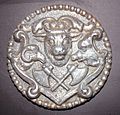butcher


The butcher (common in central and eastern Germany ), also butcher ( southern and southwest Germany , North Rhine-Westphalia , Switzerland , western Austria ), butcher , butcher and Küter ( northern Germany ) as well as butcher and butcher ( Austria ), is an old craft occupation . Butchers deal with the slaughter and the production of meat and sausage products , they work in slaughterhouses and butcher shops .
history
The first evidence of these activities can be found among the Gauls who made sausages .
In northern Germany in the Middle Ages the butchers who were organized in guilds or guilds who processed and sold the meat were known as bone cutters. In many cities, for example in Bremen or Hanover, there are still the street names Bonehauergasse and Bonehauerstraße , in Hildesheim the Bonehaueramtshaus . The craftsmen responsible for the slaughter were called Küter (see Küterstrasse in Kiel and - until 1940 - in Riga, Kütertor in Kiel, Lübeck, Stralsund, Rostock) because they received the animals' entrails ( mnd. Küt ) and heads as wages . The meat hall in Zurich was one of the traditional meat markets .
The job description of the butcher has changed a lot in recent years. Instead of slaughtering, meat is refined today. Due to this change in the profession and the associated concentration on a few slaughterhouses, the processing of slaughter-warm meat for the production of boiled sausage, which was customary until the 1970s, is almost no longer possible. For this, a close connection between slaughter and processing is necessary, as the meat has to be boned , selected and processed within twelve hours .
Regional distribution of the names
The name butcher became the sole name of the trade in Germany in 1966, but it has not been able to displace the widely established names butcher, butcher and meat chopper . Metzger has remained the predominant name, especially in southwest and south Germany and in Switzerland . In East Germany, the profession is referred to as a butcher, in some areas also as a butcher . In the north of the German-speaking area, the butcher is referred to as a butcher (sometimes also butcher ); in Austria butchers and butchers are the most common varieties. The historical variants, butcher or southern German Metzler , however, have almost died out.
Personal equipment of the butcher
|
|
During the slaughter work, the butcher always has his knives close at hand and safely stored in the knife quiver, strapped to his belt. The sharpening steel is also attached to the belt and always ready to hand.
Meat products on a painting by Pieter Aertsen
education
Germany
The training to become a butcher takes three years.
Compulsory qualifications
- Disassemble
- Production of boiled and raw sausage
- etc.
Elective qualification Two must be chosen, at least one of them from numbers 1 to 3
- Butcher
- Manufacture of special meat and sausage products
- Making dishes
- Event service
- Customer advice and sales
- Packing products
Austria
The training to become a meat processor takes three years. The training to become a meat seller takes three years.
Switzerland
The training to become a meat specialist EFZ lasts three years.
The focus is on meat production, meat processing and meat refinement.
Training opportunities
Germany
- specialization
- Meat cutter
- Poultry butcher
-
Advancement training
- Master butcher
- Technician - food technology (meat processing technology)
- Meat Technology (Dipl.-Ing.Food Technology)
Switzerland
- specialization
- Smokehouse, salting, sausage, purchasing, sales, caterer, party service
- Meat sommelier
-
Final apprenticeship examination (LAP)
- Meat specialist with federal diploma Certificate of proficiency
- Food technologist / -login with federal diploma Qualification
-
Higher professional examination (HBP)
- Master butcher
-
Higher technical college
- Graduate food technologist FH, specializing in the meat industry
See also
literature
- Georg Wenger: The chemistry and technology in the butcher's trade . (= Hartleben's chemical-technical library , volume 231). A. Hartleben's Verlag, Vienna 1898 DNB 363049711
- Bernhard Gahm: House battles - butchering, cutting up, sausage . 5th edition, Ulmer, Stuttgart 2008, ISBN 978-3-8001-5555-2 .
Web links
Germany:
- German Butcher Association eV
- Butcher in the appointment of the Federal Employment Agency
Austria:
Switzerland:
Individual evidence
- ↑ Distribution (German studies of the Phil.-Hist. Fac. Augsburg)
- ^ Alfred Schönfeldt: Spatial and historical layers of designation in the German synonymy of the butcher and butcher , Marburg 1962, DNB 481299564 ( dissertation University of Marburg 1962, 164 pages), p. 78.
- ↑ A map of the distribution of the various terms in the German-speaking area (based on the dissertation by Alfred Schönfeldt) can be found in Werner König: dtv-Atlas German Language. 15th, revised and updated edition. Deutscher Taschenbuch Verlag, Munich 2005, p. 196. ISBN 3-423-03025-9 .
- ↑ "Second Round - Metzger" , Atlas on German Everyday Language (AdA), Phil.-Hist. Faculty, University of Augsburg, November 10, 2005.
- ↑ https://www.gesetze-im-internet.de/bundesrecht/fleiausbv_2005/ overall.pdf
- ↑ http://berufenet.arbeitsagentur.de/berufe/start?dest=profession&prof-id=3677
- ↑ http://berufenet.arbeitsagentur.de/berufe/start?dest=profession&prof-id=5873






